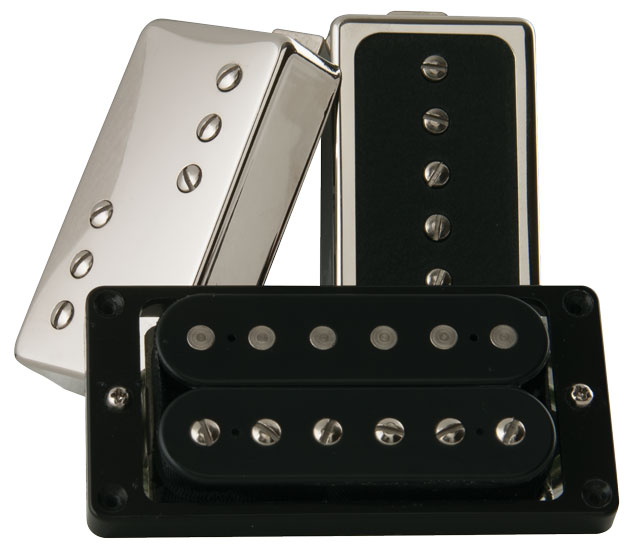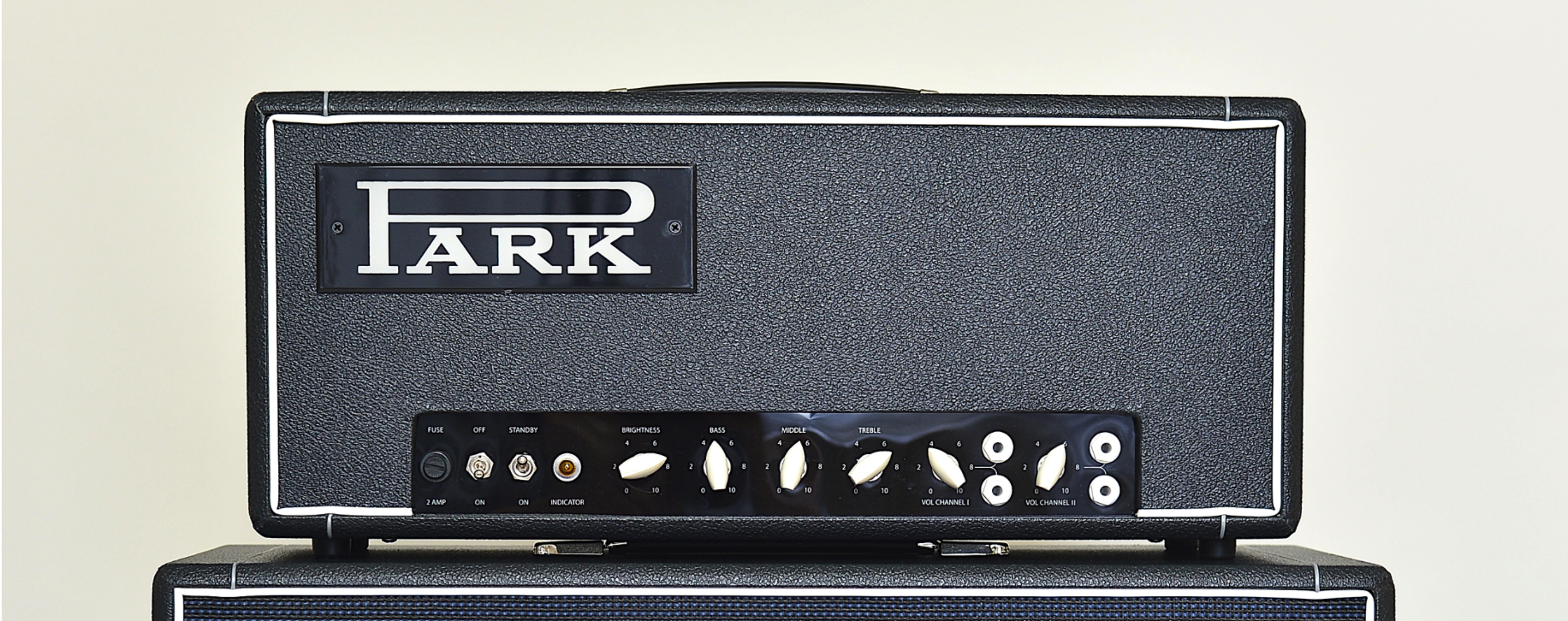The Jimi Hendrix Song "Spanish Castle Magic" is an allusion to the historic event of Christopher Columbus planning to voyage to the New World, North America.
Gibson Billy Gibbons Ultimate SG
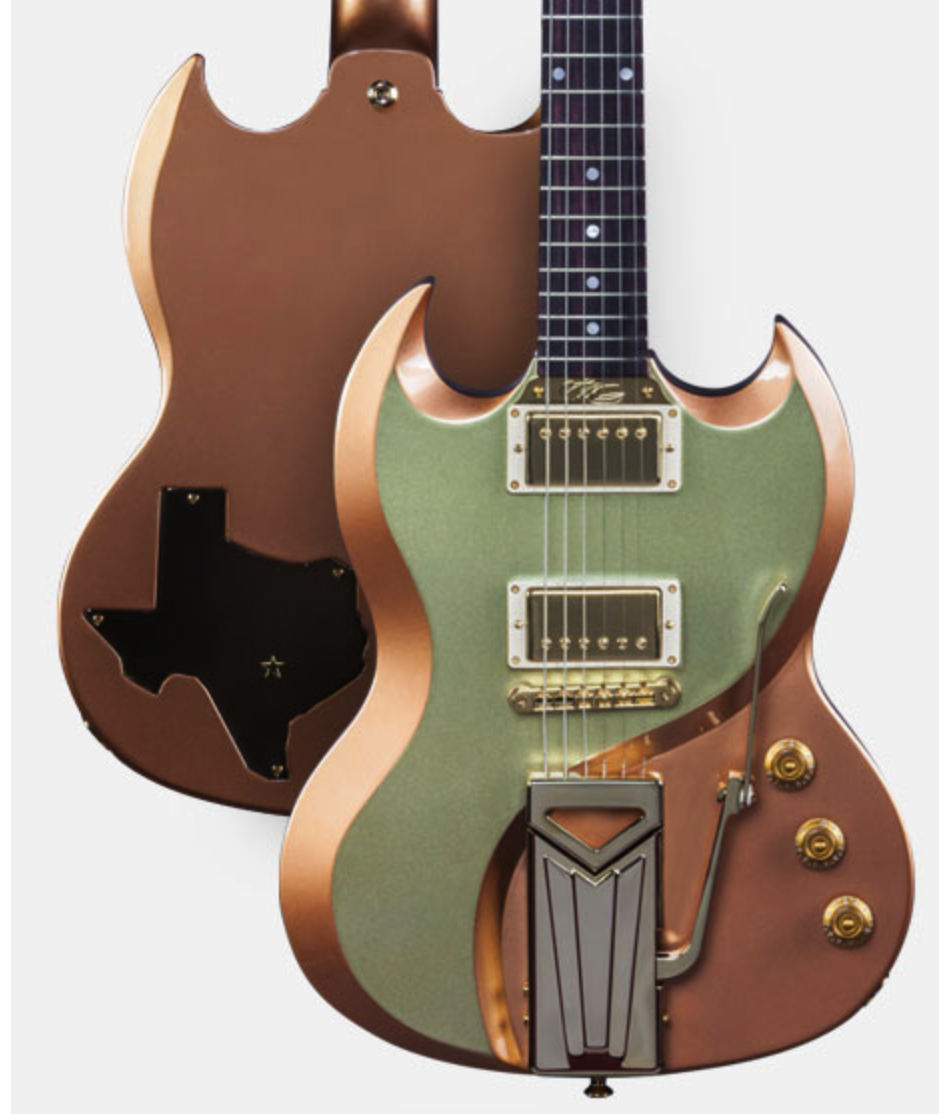 Nashville, TN (October 20, 2015) -- As beautiful as the sun rising over the Texas desert, the new Gibson BGSG designed by none-other than the legendary Billy Gibbons sets a new “gold” standard for premium guitars. The instrument is part of an exclusive arrangement with Neiman Marcus, which will include the BGSG in its winter holiday catalog. So far only two of these BGSG beauties have been hand-built by the Gibson Custom Shop. The platform for the BGSG – shorthand for “Billy Gibbons SG” — is a classic 1961 SG, but there are radical differences. The most obvious is the guitar’s top, which is raised on its upper two-thirds with a curve just below the whammy bar that recalls the smooth lines of the classic cars that Gibbons is so found of — very much like the swell of a vintage Cadillac’s elegant tail fin. The golden lacquer is a classic auto paint shade and if you remove the vibrato arm’s cover to expose the heavy duty spring-works, it looks simply fantastic. The lacquer is applied to the guitar’s hollowed mahogany in the traditional way while the plating is done using the PVD (physical vapor deposition) method ensuring a scratch resistant finish and less tarnishing. The neck is mahogany, for excellent resonance, with a rosewood fingerboard and a rounded Gibson Flying V style headstock. It’s all decked with matching gold hardware, including the sideways vibrato arm.
Nashville, TN (October 20, 2015) -- As beautiful as the sun rising over the Texas desert, the new Gibson BGSG designed by none-other than the legendary Billy Gibbons sets a new “gold” standard for premium guitars. The instrument is part of an exclusive arrangement with Neiman Marcus, which will include the BGSG in its winter holiday catalog. So far only two of these BGSG beauties have been hand-built by the Gibson Custom Shop. The platform for the BGSG – shorthand for “Billy Gibbons SG” — is a classic 1961 SG, but there are radical differences. The most obvious is the guitar’s top, which is raised on its upper two-thirds with a curve just below the whammy bar that recalls the smooth lines of the classic cars that Gibbons is so found of — very much like the swell of a vintage Cadillac’s elegant tail fin. The golden lacquer is a classic auto paint shade and if you remove the vibrato arm’s cover to expose the heavy duty spring-works, it looks simply fantastic. The lacquer is applied to the guitar’s hollowed mahogany in the traditional way while the plating is done using the PVD (physical vapor deposition) method ensuring a scratch resistant finish and less tarnishing. The neck is mahogany, for excellent resonance, with a rosewood fingerboard and a rounded Gibson Flying V style headstock. It’s all decked with matching gold hardware, including the sideways vibrato arm.
Under the hood, the BGSG is powered by a pair of Gibbon’s signature Seymour Pearly Gates humbucking pickups, of course. And the tone and volume controls are also distinctly Gibbons arrayed — lean to the bone. Two speed dials control the volume of each pickup, and there’s a third dial for tone. The elegant appointments don’t end with the guitar. Each hardshell case has been hand-painted by Nashville-based artist James Willis, a former artist-in-residence at the Gibson Custom Shop. His Texas themed work atop the cases includes the Alamo, the “yellow rose of Texas,” armadillos, a cow skull and a rendering of the guitar inside. And each BGSG comes with a certificate of authenticity that’s a brass plate with white etching in a leather binder. Like the man himself, the BGSG is first class all the way!
DRS Racks Modular Storage System
 DRS Racks’ modular, stackable storage system is the first of its kind available as a flat packaged, easy to assemble, furniture grade stringed instrument storage system. Equally at home in a living room or the studio, DRS Racks are designed around the principle of maximizing available floor space without sacrificing function for appearance. Our system allows the user to select between multiple ground units, or the ability to stack them for maximum storage.
DRS Racks’ modular, stackable storage system is the first of its kind available as a flat packaged, easy to assemble, furniture grade stringed instrument storage system. Equally at home in a living room or the studio, DRS Racks are designed around the principle of maximizing available floor space without sacrificing function for appearance. Our system allows the user to select between multiple ground units, or the ability to stack them for maximum storage.
For those who need a more organized solution for case storage, DRS offers an optional alternate brace that allows for case convenient case storage. The modular, user-assembled design allows for multiple configurations to accommodate instruments and cases of most designs.
The DRS system utilizes environmentally friendly solid bamboo for its construction. When assembled, the units are freestanding and do not require unsightly anchoring. The system assembles easily, using the single Allen wrench included, and the flat-pack packaging design allows for inexpensive shipping anywhere in the world. Its contact points are all finish safe materials and are replaceable if damaged.
Mason BD10 Hybrid Bass Driver
 Maxon’s rich history in the overdrive realm spans more than four decades, and the company’s contribution to some legendary guitar tones is well known. And now Maxon joins the bass-overdrive game with the new BD10 Hybrid Bass Driver.
Maxon’s rich history in the overdrive realm spans more than four decades, and the company’s contribution to some legendary guitar tones is well known. And now Maxon joins the bass-overdrive game with the new BD10 Hybrid Bass Driver.
The BD10’s circuit is based on Maxon’s OD808 design. The compact pedal’s 5-knob landscape features individual bass and treble controls, a drive control, plus knobs to set the drive and clean outputs levels for precise tweaking. It runs on a 9V battery or standard AC adaptor (not included).
The BD10 covers much tonal territory, but if you’re looking for balls-to-the-wall distortion, this isn’t the place. The BD10 is more about sweet, warm, natural-sounding overdrive. I started out with the low and high knobs at 3 o’clock and noon, respectively, and pushed the drive knob to 1 o’clock and the two level controls to noon. The resulting tones—smooth, beefy, and tube-like—had just the right amount of dirt and boost to let me pretend I was Roger Glover. Almost diming the drive knob and inching up the drive level past 3 o’clock brings thicker, Fu Manchu-style distortion. No matter the settings, I was impressed by the touch sensitivity, clarity, sustain, and naturalistic sound while enjoying how the low end remains intact.
There are many bass overdrives to choose from, and plenty for a lot less coin. But when you consider the BD10’s excellent tones and remarkable tweakability, this little white box is well worth a look.
Humbucker-Sized P-90 Review Roundup
For most players, the pendulum of guitar-pickup fashion seems to swing between humbuckers—be they vintage, PAF-style or something more modern—and some type of take on Strat- or Tele-style single-coils. But lurking somewhere in the middle is a pickup type that’s often overlooked: the P-90-style single-coil.
Gibson invented the P-90 and used it in many guitars between the pickup’s 1946 debut on through the dawn of the humbucker a decade later—and thereafter it became a mainstay on once-budget-priced models such as the Les Paul Junior or Les Paul Junior Special. Though the humbucker’s powerful tones and noise-free performance largely overshadowed the P-90, a vocal minority of players has long preferred the P-90’s crisper tones, clearer mids, and potentially ragged edge.
The P-90 is probably most associated with raunchy rock, from the Gibson SG Special Pete Townshend demolished at Leeds to Billie Joe Armstrong’s hard-working Les Paul Junior. Punk pioneers such as New York Doll Johnny Thunders and the Clash’s Mick Jones loved its raw intensity. And for some, the definition of P-90 attitude begins and ends with Leslie West’s tone on Mountain’s “Mississippi Queen.”
But the P-90 isn’t always rude-sounding. Consider the Beatles, who used P-90-equipped Epiphone Casinos throughout the band’s middle years. Even jazz players have embraced it, notably Grant Green and Wes Montgomery. (Wes played a Gibson ES-175 with P-90s until switching to a Gibson L5 with humbuckers in the latter part of his career.)
A Single-Coil Compromise? It’s probably an oversimplification to say that the P-90 splits the difference between a vintage-style Fender pickup and a humbucker, yet there’s some truth to the notion. The most likely P-90 converts are humbucker users who yearn for brighter tones and snappier attack, and single-coil players who wish their pickups had more midrange muscle.
Like humbuckers, P-90s rely on a bar magnet with steel pole pieces, as opposed to the individual magnetic pole pieces of most Fender pickups, an architecture that tends to deliver fatter mids and less twang than classic Fender single-coils.
Though the humbucker’s powerful tones and noise-free performance largely overshadowed the P-90, a vocal minority of players has long preferred the P-90’s crisper tones, clearer mids, and potentially ragged edge. Yet P-90s tend to sound twangier and more transparent than vintage-style humbuckers. (And yes, P-90s transmit 60-cycle hum just like most non-humbucking pickups.)
Chances are, more players would explore the P-90 sound if the pickups fit into guitars with Fender- or Gibson-style routing. But both traditional versions of the P-90—the “dog ear” and “soap bar” styles—require guitars specifically routed for those formats. That’s why so many manufacturers have started issuing humbucker-sized P-90-style pickups.
P-90 or Not? Please note the words “P-90-style.” None of the pickups covered here are true P-90s. As experts like Seymour Duncan, Lindy Fralin, and Jason Lollar hasten to point out, even if you use the same materials and manufacturing methods that Gibson employed in the 1950s, simply changing the format from the original P-90’s wide, low coil to the humbucker’s relatively tall, narrow one inevitably alters the tone. The most common compromise is to use thinner pickup wire (say, 43 gauge instead of 42) to permit the traditional number of winds on a humbucker-sized bobbin. But even then, the result won’t sound exactly like the original—or rather, the originals.
Like all vintage pickups, old P-90s exhibit major variations from unit to unit. The number of pickup-wire winds—which determines the output—can vary greatly. Magnet strength is also inconsistent: Gibson used varying types of alnico magnets, depending on what was available at production time. And in many cases, the qualities that make a player treasure a particular P-90 are environmental in origin, such as the degaussed magnets that can result from poorly stored pickups or habitually leaning a guitar against an amp’s speaker. Also, the practice of winding bridge pickups hotter than neck pickups (as most of the sets covered here do) is a strictly modern innovation. They just weren’t thinking that way in the 1950s.
As a result, this roundup doesn’t attempt to evaluate pickups in terms of vintage-style authenticity. Instead, I’ve tried to describe the pickups in objective terms with the aim of steering players toward the product that best suits their needs and tastes.
Catalinbread Fuzzrite Review
The original Mosrite Fuzzrite has always lurked in the shadowy recesses of the classic fuzz temple. To most ears, it’s not as flexible as a Fuzz Face, as meaty as a Muff, or as detailed and defined as a Tone Bender. These perceived shortcomings have mostly relegated the Fuzzrite to worship by the garage punk and biker fuzz cults (and even among these sects, divisions over the merits of germanium and silicon versions persist). But all dogma, bias, and historical slights aside, a good Fuzzrite is a way-cool and super-spirited stomp overflowing with personality.
Catalinbread’s new Fuzzrite (we’re not sure how they managed to secure the rights to this legendary name) is a take on the silicon version of the circuit that first appeared in the late ’60s. And though it might not appeal to germanium Fuzzrite fans or super-obsessive ’60s sonic purists, it’s a fat, substantial, and buzzing fuzz that occupies a hard-to-nail sonic niche where ’60s sizzle and modern heaviness meet.
Built Like a Buzzing Brick Catalinbread pedals tend to be superlatively built, and on the Fuzzrite you don’t have to look hard to find evidence of this quality. You can’t see the transistors, capacitors, and resistors because the circuit board is mounted with those components facing the enclosure’s interior. But like any Fuzzrite circuit, it’s a simple affair. And apart from the two transistors at the heart of the circuit, there probably aren’t more than a dozen additional components on the board.
The Fuzzrite’s happy relationship with small amps makes it a fantastic studio tool for generating hairy vintage fuzz tone that doesn’t feel out of control. Foreseeing, perhaps, the potentially rowdy environments in which the pedal might be put to work, Catalinbread made sure the guts are locked down tight as submarine latches on this beautifully robust box. The circuit board is held in place by the sturdy footswitch and volume and depth knobs, but it’s also held in place by small steel braces that are affixed directly to the enclosure. The two knurled knobs are easy to grip with the toe of your sneaker if you want to nudge the fuzz or volume on the fly. But they provide the perfect amount of resistance for doing so, and are unlikely to be bumped out of whack once you’ve set them where you want them.
In a Fuzz Kind of Eden Silicon Fuzzrites tend to respond to chords in a cool and unique way. The Catalinbread gets especially high marks on this count, injecting power chords with throaty, muscle car mass topped with just the right amount of ’60s rasp. The Catalinbread’s marriage of vintage and meatier, contemporary fuzz personalities pay big dividends in this chordal context.
Probably one of the biggest obstacles to a wider acceptance of the original silicon Fuzzrite was its inorganic pick attack. Where a germanium Fuzz Face—or Tone Bender in particular—tend to communicate the interface between string and pick in a relatively transparent way, a Fuzzrite sounds more like fuzz floodgates opening and slamming shut. That hasn’t changed profoundly on this Fuzzrite, but by highlighting pick attack and adding definition about as well as a silicon Fuzzrite circuit can, the Catalinbread proves itself exceptionally responsive for the breed. Fast flurries of fuzz-fried licks sound a lot airier and detailed as a result.
Ratings
Pros: Cool mixture of contemporary fat silicon fuzz tones and sizzling ’60s sounds. Superlative build quality.
Cons: Not very responsive to guitar volume changes. Lacks some seat-of-the-pants character of ’60s fuzzes.
Tones:
Ease of Use:
Build/Design:
Value:
Street: $149
Catalinbread Fuzzrite catalinbread.com
The sometimes binary attack of the Catalinbread Fuzzrite makes it a great match for amps with a bit of natural compression. It loved my blackface Tremolux and a silverface Champ—even a much less squishy blackface spec’d Bassman sounded smooth, contoured, and dynamic with the Fuzzrite torturing the front end. It’s easy to imagine how the Fuzzrite’s scathing top and a squishy Fender tweed circuit would add up to bliss. And the Fuzzrite’s happy relationship with small amps makes it a fantastic studio tool for generating hairy vintage fuzz tone that doesn’t feel out of control.
Guitar volume-control responsiveness? Well, there’s not a lot—at least if you looking for Fuzz Face-style fuzzy-to-clean dynamics. Reducing guitar volume can re-color the fuzz in interesting ways, however, and you can enhance the cool, sputtery gated-fuzz effects by setting the depth (gain) control to lower levels.
In general, the Fuzzrite sounds happiest with the fuzz at or near it’s maximum level. That said, the volume control has a wide, effective range, and some of the coolest and most authentically ’60s-sounding tones come at very low pedal volumes, a trait that further bolsters the Fuzzrite’s utility in the studio.
The Verdict Bold, brawny, and buzzy as a pissed-off wasp, the Catalinbread Fuzzrite is the rare fuzz that might appease paisley and Chelsea-booted fuzz purists, as well as players who think they love ’60s fuzz but really need a touch of modern silicon muscularity. There might be slightly more affordable and authentic takes on the Fuzzrite circuit, and some vintage-fixated players will certainly find the Catalinbread’s relative smoothness a bit too civilized for their garage punk needs. But few Fuzzrite clones out there are built to the exacting tolerances or offer the battle-ready robustness of this little unit. And for many players who are discovering the joys of this menacing and monstrous circuit, the sounds on tap will be a revelation.
Celestial Effects Aries Beast Distortion Review
Celestial Effects’ Aries Beast Distortion is a pedal worthy of its astrological namesake. It’s intense, forceful, and hot-blooded. And while countless pedals have attempted to crack the heavy-amp-in-a-box code with mixed results, the Aries gets very close, thanks to a unique EQ section with two flexible gain stages.
God of War The Aries’ two gain stages are op-amp driven. One has no clipping stage, and it cascades into the second op-amp stage, which uses MOSFET clipping diodes. The very different voices of the two gain stages—and the fact they can be adjusted individually—is critical to the variety of distorted tones. The first stage, which is controlled by a single knob—gain—sounds open and wide. The clipping-diode stage has a tighter, more compressed sound and is controlled by the drive knob.
The mid sweep is very wide, and the pedal’s more dimensional midrange has presence akin to a cranked Marshall. The Beast’s 3-band EQ is key to the pedal’s sonic possibilities. Treble blends the signal coming from the treble capacitor with the signal going to the bass and mids controls. Turning it up reduces overall volume a bit, while turning it down adds bass and midrange. Reps from Celestial say they could have defeated the loss in volume with a larger treble cap, but found that the smaller cap gave the pedal the voice they were after. Celestial also designed the circuit with as little noise filtering as possible in order to maximize signal pass. The unit can be powered with a 9V battery, a center-negative 9V adapter, or an 18V center-negative adapter, the latter of which yields higher headroom.
Ratings
Pros: Muscular, touch-responsive distortion. Wide-ranging, interactive controls. Built like a rock.
Cons: Can be difficult to balance dirty tones with an amp’s clean channel.
Tones: Ease of Use: Build/Design: Value: Street: $179
Company celestialeffects.com
Zodiac Killer With a Gibson Les Paul, a Soldano Lucky 13, and the Aries’ controls at noon, the pedal unleashed a brutal, meaty distortion. The midrange was cutting, with a trace of cocked-wah honk—but with a very muscular body underneath. It reminded me a lot of Alice in Chains and early Undertow-era Tool, and was perfect for heavy dropped-D riffing and sustained leads on low notes. Not too many high-gain distortion pedals highlight mids this prominently, and according to Celestial that was a design goal. The mid sweep is very wide, and the pedal’s more dimensional midrange has presence akin to a cranked Marshall. The Aries’ EQ section, too, has a very Marshall-like response and feel. The mids and lows react interestingly to changes from the treble knob—rising and receding in prominence along a nice, even curve as I increased or reduced high end.
The gain section is interactive and varied, too. Lowering the gain to 10 o’clock and increasing the drive to 3 o’clock yielded fierce, Dual Rectifier-like growl with searing highs and tight lows—perfect for palm-muted riffing. The midrange control, meanwhile, is both sensitive and rangy at these drive levels—making it a cinch to achieve heavy, scooped Dimebag Darrell tones. Raising gain to 2 o’clock and dropping drive to 11 o’clock expanded the harmonic content of the low end and opened up the high end, yielding a crunchy, British-style overdrive that was smooth and extraordinarily touch responsive. And when I lowered the volume controls on my Les Paul, the roaring distortion morphed into a sweet, purring, plexi-like overdrive.
The Verdict For all-out aggressive distortion with amp-like responsiveness, it’s hard to go wrong with the Celestial Effects Aries Beast Distortion. It has more than enough gain to satisfy the can’t-get-enough-dirt set. Its onboard EQ and dual distortion circuits offer a lot of versatility, and it’s a sturdy mother of a pedal. All the range in the EQ and drive section means it demands a little practice and get-acquainted time. But the investment will, for many, reveal a thrilling and uncommonly versatile distortion tool.
Park 45 Amplifier Review
Many Marshall fans are hip to the parallel history of Park Amplification—Jim Marshall’s other amp line, created to maximize sales without violating Marshall’s distribution contracts. Despite their distinct look, Park amps of the ’60s and early ’70s were similar to the era’s Marshalls, and are exceedingly collectible.
Now, many years after Park’s demise, the brand name returns via a high-end line of hand-wired, U.S.-made amps under the leadership of longtime Marshall and Vox veteran Mitch Colby. We checked out the new Park P45, a 2-channel, 4-input, 45-watt head powered by a pair of KT66 power tubes, JTM45-style. (Park also offers a combo version with a pair of 12" Celestion Heritage G12Ms.)
Park vs. Marshall I was hazy on the exact circuit variations between ’60s Marshalls and Parks, so I queried an expert on vintage British amps: Colby himself. As he explained via email: “In general, Park amps were closer to the bass or PA versions of the equivalent Marshall amps. You rarely find Park amps with bright caps on the volume control (no cap equals the bass version). Sometimes there’s not even a cap across the ‘bright’ channel mix resistor, as in the PA version. Without both caps, the channels sound exactly the same, as in the PA version. So Parks are typically warmer-sounding than the equivalent Marshalls.”
Like a ’60s Marshall bass model, the new Park omits the bright cap, but retains the one at the mix resistor. (Colby notes that, contrary to the official Marshall “Lead” schematic, some early units omitted the part as well.) Colby says this arrangement “sounds best and most ‘vintagy’ to me.”
Even playing bone dry, there’s enough mass and complexity to hold your interest. These tones aren’t likely to get lost in the mix. Parks and Re-Creation The Park P45 certainly looks like a ’60s amp. Its solid-wood head cabinet bears the original white-on-black Park logo on a sheet of Plexiglas. The external hardware is hefty. The simple controls are period-accurate: bass, mid, treble, and brightness, plus a single volume control for each channel. (The knobs face forward, not skyward as on vintage “top-mount” Parks.) Like early Marshalls and Parks, the P45 has no gain/overdrive control—you generate crunch by turning up or adding a distortion pedal. (Our review model also includes the optional post-phase-inverter master volume control, mounted in back in lieu of one of the speaker-out jacks.)
Within the stout aluminum chassis, components are handwired on turret board. The soldering is immaculate, and the lead dress (the physical routing of the wires) is precise and elegant. There are no mojo ingredients, though—the parts are modern, including the plastic jacks and tube sockets. The transformers are custom-made for Park by ClassicTone/Magnetic Components. (Park also offers a pricier limited edition model with a Merren Audio output transformer and NOS capacitors and resistors.) A formidable pair of Gold Lion KT66s tower over three adjacent 12AX7s and a GZ34 rectifier tube. The amp weighs in at a manageable 31 pounds. It’s a quality build that seems to promise many years of use.
Park It Here! I auditioned the Park P45 through a 2x10/1x12 THD cabinet, miking the 12" speaker for the audio examples. My test guitars were a recent-model Les Paul Traditional and an original ’63 Strat.
To some, Marshall/Park means crunch, the whole crunch, and nothing but the crunch. But as anyone who’s spent quality time with early Marshall circuits can attest, they also deliver superb clean tones. It’s a weighty sort of clean, with strong, harmonious sustain and fundamentals as solid as poured concrete. My Les Paul tones were bluntly authoritative, yet I still got pretty top-end shimmer from my old Strat. Even playing bone dry, there’s enough mass and complexity to hold your interest. These tones aren’t likely to get lost in the mix.
Ratings
Pros: Powerful clean tones. Iconic crunch. Excellent handwired workmanship.
Cons: No gain controls, tremolo, reverb, or effect loop. Pricy.
Tones:
Ease of Use:
Build/Design:
Value:
Street: $2,500
Park P45 parkamplifiers.com
Naturally, iconic Marshall crunch accumulates as you advance the volume knob. Among the coolest settings are ones perched on the brink of distortion, tipping one way or the other according to your touch. Even at maximum volume, tones remain dynamic—you can get countless variations via small adjustments of your guitar’s volume knob.
Might As Well Jump With two inputs per channel, you can link the channels in series using a short cable. This yields a fine rendition of the primal high-gain sound that helped define heavy guitar. But don’t expect a modern metal sound—you don’t get the steroidal lows and spitting attack of some contemporary high-gain heads. That’s generally a plus: The Park P45’s relatively manicured lows never overpower your tones, maintaining excellent note definition, even in the face of extreme tube “sag.”
If you need crisper crunch with snappier attack, just dial in a relatively clean sound and add a distortion pedal. I loved the results I got with various ’60s-style germanium fuzzes and boosters, especially single-transistor, Rangemaster-style circuits. Between such dynamically responsive pedals and such a dynamically responsive amp, you can get an enormous range of overdrive colors just by tweaking the relative volume levels of guitar, pedal, and amp. In other words, the Park P45 can be vastly more versatile than its simple controls might suggest.
Meanwhile, the amp’s ample headroom and solid note definition work splendidly with modern effects. Hell yeah, the Park P45 excels at “Beano”-era Clapton lines and proto-Zep riffage. But its tones don’t sound dated in the slightest, and they make a solid platform for non-retro tone sculpting too.
The Verdict This is a fine modern rendition of a fine vintage design. The build quality is excellent, and the amp is a pleasure to play and record. The Park P45 easily nails the expected classic rock tones, but why stop there? Imaginativeplayers will find countless uses for this bold and versatile instrument.
Duchess V40 Amplifier : Neo-Boutique Standard
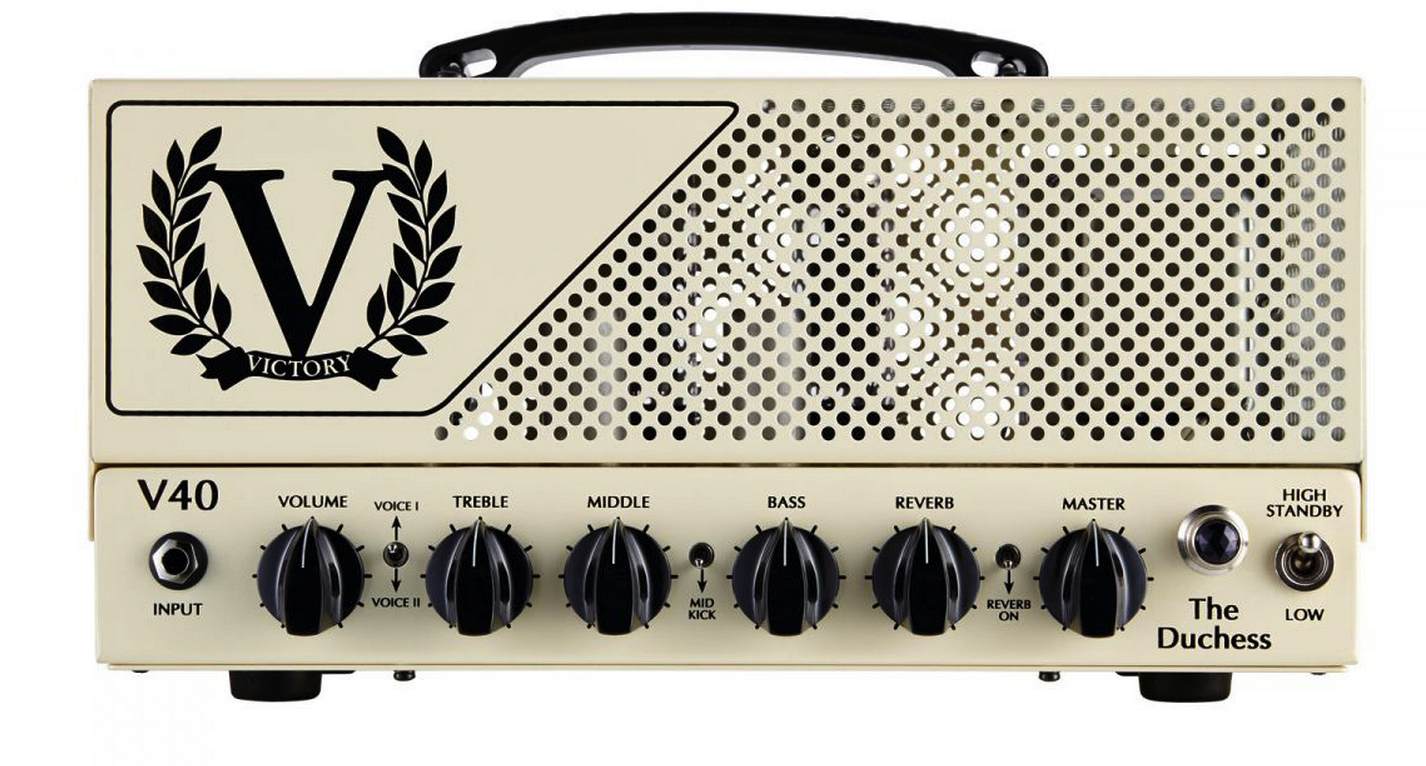 In heir to the great dumble-clone amp builders such as Two-Rock, Fuchs, Amplified Nation, Cieratone, Quinn, Hamiltone - Comes the Duchess V40 single-channel all-valve tube amplifier. While original innovators of the dumble-spinoff market Two-Rock focused on a global concept of a "hook" which resulted in the "Contour" knob and bucked the idea of the primitive Marshall "Presence" (Patent:Schematic) by adding a complete and round-sound midrange scoop which essentially exemplifies the qualities shown in the early Two-Rock benchmark amplifiers such as the John Mayer Signature model. The Duchess attempts to go one better by doing away with this concept entirely to allow the listener to feel one step more intimate with the raw sound generated by their actual vacuum tubes. The result is a beautiful all purpose single channel amplifier which acts as a glassbox of tube-tone in a seductive perforated chassis which is a far-cry from "woman-tone".
In heir to the great dumble-clone amp builders such as Two-Rock, Fuchs, Amplified Nation, Cieratone, Quinn, Hamiltone - Comes the Duchess V40 single-channel all-valve tube amplifier. While original innovators of the dumble-spinoff market Two-Rock focused on a global concept of a "hook" which resulted in the "Contour" knob and bucked the idea of the primitive Marshall "Presence" (Patent:Schematic) by adding a complete and round-sound midrange scoop which essentially exemplifies the qualities shown in the early Two-Rock benchmark amplifiers such as the John Mayer Signature model. The Duchess attempts to go one better by doing away with this concept entirely to allow the listener to feel one step more intimate with the raw sound generated by their actual vacuum tubes. The result is a beautiful all purpose single channel amplifier which acts as a glassbox of tube-tone in a seductive perforated chassis which is a far-cry from "woman-tone".
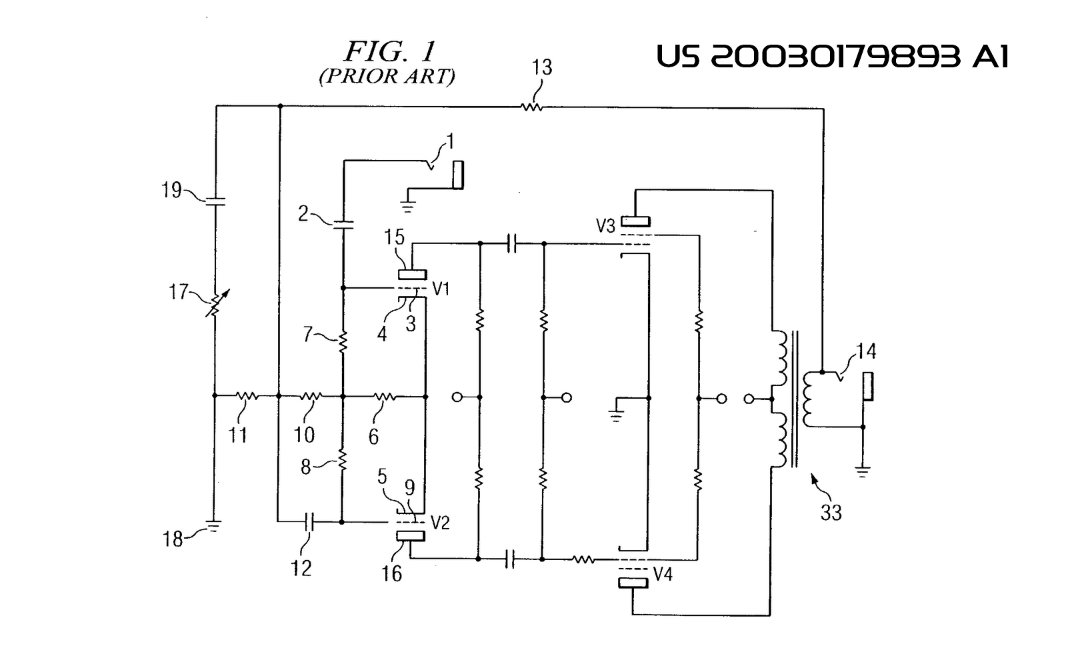

JHS Prestige Buffer/Booster
With the plethora of effects available these days it's no surprise buffer effect pedals have become a new craze. While not glamorous or poetic by nature, these buffer pedals have a very important role to provide the base tone of your guitar as it runs through several pedals and produces high end signal lost. Today I am going to talk about a buffer pedal that I am rather excited about the JHS Prestige. It comes in a nice efficient micro package similar to other JHS pedals and also similar to other buffer pedals such as those produced by Mooer. I have owned a JHS Little Foot Fuzz pedal and was very impressed with the saturating analog fuzz tone produced which almost had a close resemblance to an overdrive effect. When the pedal is engaged with the knob at 0 the Prestige produces a clean volume boost similar to a Keeley Katana although when dimed will give you a result of approximately 27 decibels. and set it anywhere in between for great lead boost tones bordering on overdrive.
BC Audio No. 10 Mk. II
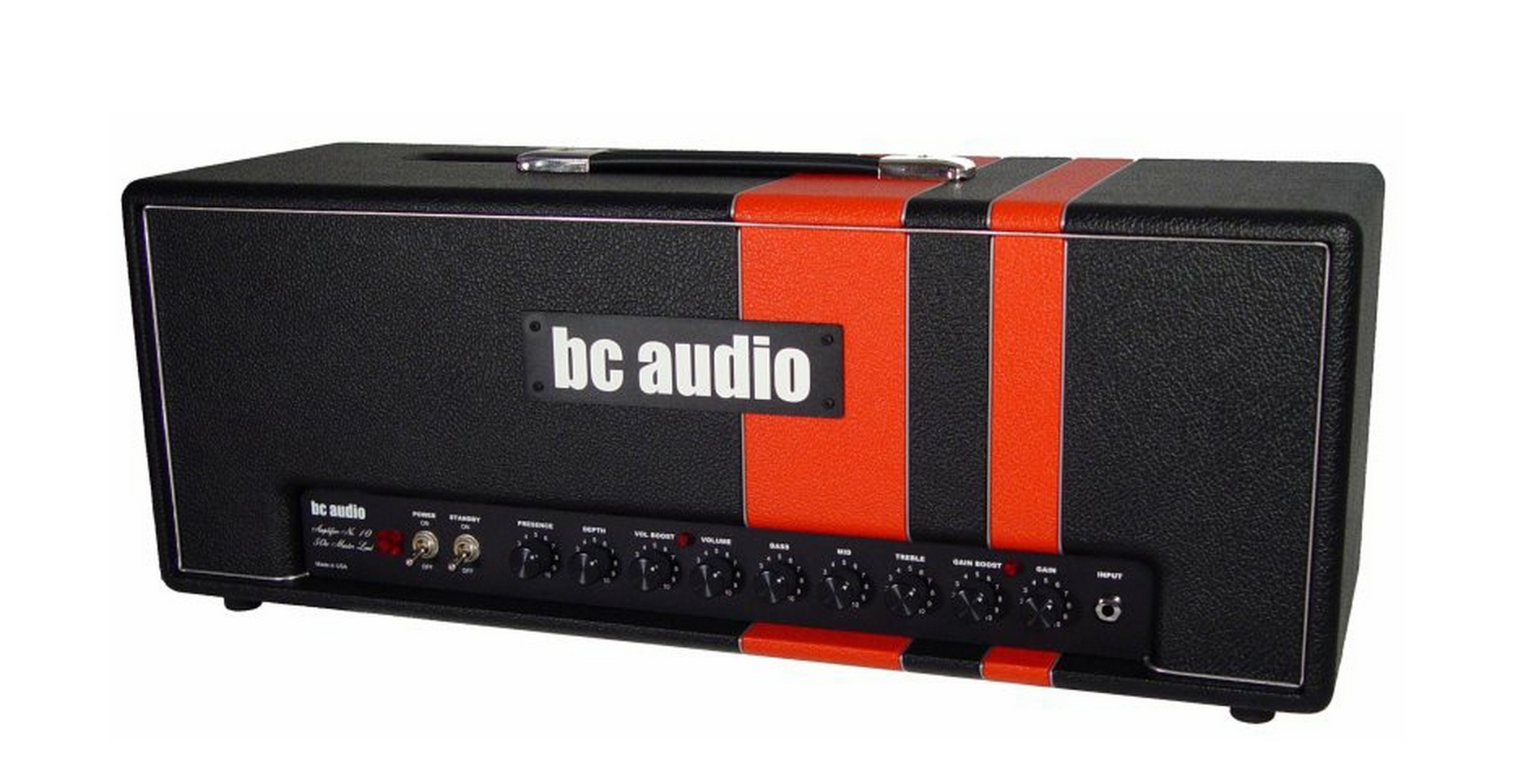 BC Audio’s No. 10 Mk. II is company founder Bruce Clement’s ode to 50-watt British amplifiers of yesteryear. But while No. 10’s appearance is clearly influenced by older Marshall plexis, it’s not a straight clone. Its circuit departs from the original formula in several ways, notably in its 6SL7-based preamp section. The result is a fire-breathing 50-watt beast that generates power tube-like saturation at relatively manageable volumes.
Loud and Proud
At the heart of the No. 10 is a beautiful all-tube circuit, hand-wired point-to-point using top-shelf components. Two EL34 power tubes provide 50 watts of power. But instead of ubiquitous 12AX7-type preamp tubes, the No. 10 relies on four octal 6SL7 tubes. These, according to BC Audio, provide more open-sounding compression and more even-order harmonics when pushed into overdrive. The goal is smooth overdrive akin to a cranked plexi, minus the ear-bleeding levels needed to attain power-tube distortion on those amps.
BC Audio’s No. 10 Mk. II is company founder Bruce Clement’s ode to 50-watt British amplifiers of yesteryear. But while No. 10’s appearance is clearly influenced by older Marshall plexis, it’s not a straight clone. Its circuit departs from the original formula in several ways, notably in its 6SL7-based preamp section. The result is a fire-breathing 50-watt beast that generates power tube-like saturation at relatively manageable volumes.
Loud and Proud
At the heart of the No. 10 is a beautiful all-tube circuit, hand-wired point-to-point using top-shelf components. Two EL34 power tubes provide 50 watts of power. But instead of ubiquitous 12AX7-type preamp tubes, the No. 10 relies on four octal 6SL7 tubes. These, according to BC Audio, provide more open-sounding compression and more even-order harmonics when pushed into overdrive. The goal is smooth overdrive akin to a cranked plexi, minus the ear-bleeding levels needed to attain power-tube distortion on those amps.
Ratings
Pros: Clear, authoritative cleans. Punchy, powerful distortion. Realistic power tube overdrive via octal preamp tubes. Independent gain and volume boosts. Exceptional build.
Cons: Possibly too loud for small venues. The 6SN7-based preamp may feel unfamiliar. Pricy.
BC Audio No. 10 Mk II bcaudio.com
The amp’s lone channel features gain, treble, midrange, bass, volume, presence, and depth controls. There are also footswitchable volume and gain boosts with independent controls and onboard LED indicators. The No. 10 also includes a tube-buffered effect loop with true bypass switching and dedicated send and return controls. The speaker load is switchable between 4, 8, and 16 ohms.
Awaken the Beast As its red racing stripe implies, the No. 10 dishes tones with the muscle of a finely tuned late-’60s Shelby Mustang. I connected a Les Paul Custom and a Bogner 2x12 cab, setting the amp gain around 10 o’clock with the mids slightly scooped. Playing bluesy Zep licks, I was floored by how lively and full the amp’s clean tones sounded. The 6SL7 tubes provide plenty of breathing room without congestion or bitter edges. Switching to a Stratocaster, I relished the sparkling harmonics of clean arpeggios and clean-toned Keith Richards-style riffing.
Regardless of guitar type, the No. 10’s tones hit me in the chest more strongly than anticipated. The amp’s delivery simply feels more powerful than equivalent amps with 12AX7s. It almost seemed silly to have an optional volume boost at my disposal, since the amp was far louder than most 50-watters I’ve encountered. Meanwhile, the amp’s attack was less focused, but broader—sort of like the difference between a cut and a hard slap. I wasn’t put off by any means—far from it!—but it takes some getting used to.
When I advanced the gain and midrange controls to 1 o’clock, the No. 10 showed how menacing it can be. The overdrive’s heavy upper-mid emphasis gave my Les Paul an aggressive bite that left few doubts about the amp’s ability to cut through a mix. Alternating between speedy EVH licks and bluesy ’70s riffs, the drive’s grittiness advanced and retreated with a response similar to a fully cranked vintage non-master volume amp. When I backed off the guitar’s volume, the tone thinned out smoothly without compromising its treble bite.
The Verdict BC Audio’s mighty No. 10 Mk. II delivers voluptuous tones, chest-caving power, and fantastic responsiveness. The build couldn’t be more rugged. The use of 6SN7 preamp tubes enables many cool tones for players seeking something a bit different from the norm. Factor in its user-friendly controls, independent volume and gain boosting, and full-featured effect loop, and the No. 10 is truly a force to be reckoned with.
TC Electronic Announces Polytune 2
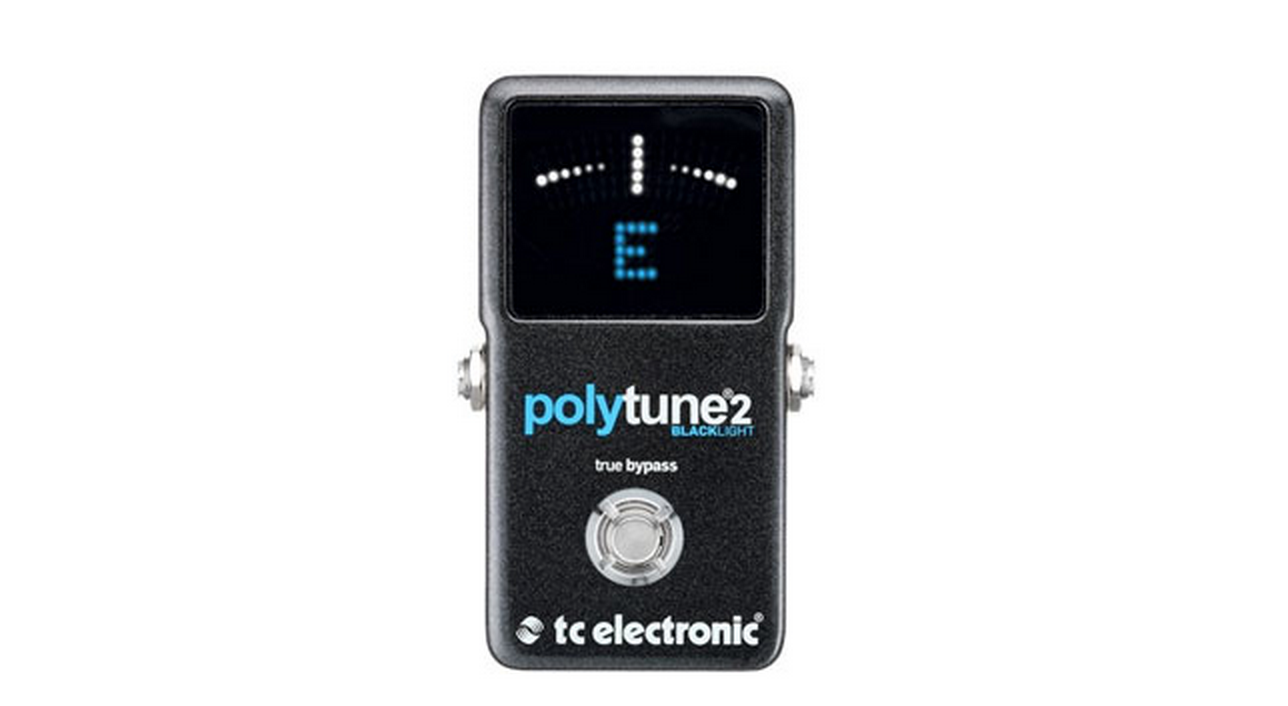 PolyTune 2 BlackLight sports everything that's made TC Electronic's polyphonic tuners the new tuning standard on pedalboards around the world. The game-changing polyphonic tuning mode that lets you tune all strings at once, the super fast chromatic tuner and the ultra-precise strobe tuner are all there, and now they are housed inside a gorgeous black metallic enclosure with a new super-bright blue and white LED-display that when lit will put even the most vivid starry nights to shame.
Features:
PolyTune 2 BlackLight sports everything that's made TC Electronic's polyphonic tuners the new tuning standard on pedalboards around the world. The game-changing polyphonic tuning mode that lets you tune all strings at once, the super fast chromatic tuner and the ultra-precise strobe tuner are all there, and now they are housed inside a gorgeous black metallic enclosure with a new super-bright blue and white LED-display that when lit will put even the most vivid starry nights to shame.
Features:
- Polyphonic Tuner
- Chromatic Tuner (+/- 0.5 cent)
- Strobe Tuner (+/- 0.1 cent)
- Super sleek black enclosure
- Stunning blue and white LED display with ambient light sensor
Available: Late June in Europe and late July in the US Price: $99.99 US Estimated Price / £65 UK SSP / 89 € EUR SSP

